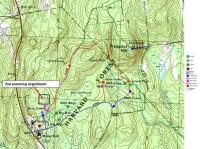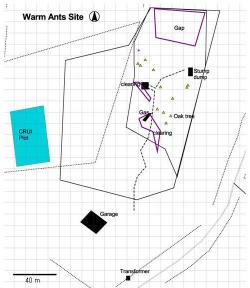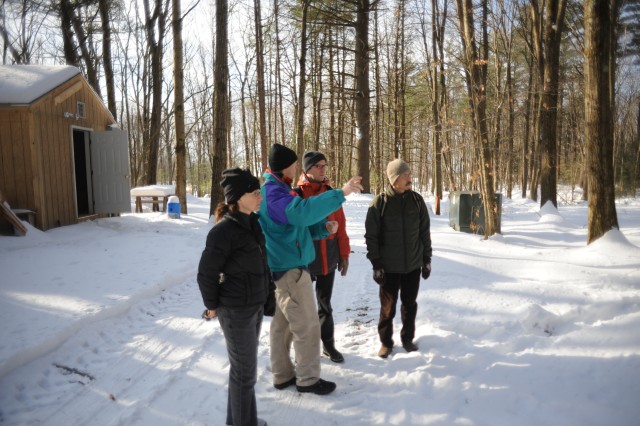You are here
Response of Ants at Harvard Forest to Climate Change
Response of Ants at Harvard Forest to Climate Change
Project Summary - People - Design and Construction - Results - Data
Project Summary:
Experimental field studies are needed to understand the consequences of global climatic change for local community structure and associated ecosystem processes. We propose to use large open-top environmental chambers to simultaneously manipulate air and soil temperatures using a statistically powerful and cost-efficient response-surface (regression) design at two field sites situated in northern and southern temperate mixed hardwood forests in eastern North America (Harvard Forest in Massachusetts, Duke Forest in North Carolina). The proposed field manipulations will reveal the effects of temperature increases on the populations, communities, and associated ecosystem services of assemblages of ground-foraging ants. Ants are a model taxon for studying effects of global climatic change because they comprise the dominant fraction of animal biomass in many terrestrial communities and because they provide essential ecosystem services, including soil turnover, decomposition, and seed dispersal. The experiment is designed to test three predictions:
- Projected atmospheric warming will lead to declines in ant species abundances at the warmer, southern extent of their ranges in the US. Conversely, projected atmospheric warming will lead to increases in abundance or range extensions of ant species at the cooler, northern extent of their ranges in the US.
- Warming will change the relative abundance and composition of ant communities, and will lead to the loss of ant biodiversity.
- Warming will potentially diminish ecosystem processes and services provided by ants, particularly with respect to the dispersal of seeds.
Twelve open-top chambers at each site which will each be exposed to one of four levels of air temperature increases, ranging from no change (ambient conditions) to 8 degrees C (commensurate with some IPCC climate model forecasts for the year 2100). The experiment will run for 3 consecutive years of continuous warming. The response variables measured will include ant activity, population densities and colony sizes of focal species, ant community diversity and species composition, and rates of seed dispersal and predation as mediated by ants. This study will provide an experimental test of the hypothesis that species at the northern and southern boundaries of their ranges will respond predictably to climatic change. In addition, this research will further establish ants as a model taxon for the study of climatic change.
This experiment is supported by the Department of Energy Office of Science (BER) Program for Ecosystem Research, Grant number DE-FT02-08ER64510
People:
Design and construction:
 The Harvard Forest ant-warming experiment ("Warm Ants") will be located within Harvard Forest's Prospect Hill tract in Petersham, Massachusetts. This heavily instrumented ~500 ha area is the focus of the Harvard Forest Long Term Ecological Research (LTER) site. In addition to the Warm Ants project, other long-term research installations on the Prospect Hill tract include three eddy-covariance towers (the EMS tower, the Little Prospect Hill tower, and the Hemlock tower); the Chronic Nitrogen addition experimental plots; a soil warming experiment; a soil warming x nitrogen addition factorial experiment; headwater stream gauges; and the prototype of the Hurricane Pull-down experiment. Shaler Hall
The Harvard Forest ant-warming experiment ("Warm Ants") will be located within Harvard Forest's Prospect Hill tract in Petersham, Massachusetts. This heavily instrumented ~500 ha area is the focus of the Harvard Forest Long Term Ecological Research (LTER) site. In addition to the Warm Ants project, other long-term research installations on the Prospect Hill tract include three eddy-covariance towers (the EMS tower, the Little Prospect Hill tower, and the Hemlock tower); the Chronic Nitrogen addition experimental plots; a soil warming experiment; a soil warming x nitrogen addition factorial experiment; headwater stream gauges; and the prototype of the Hurricane Pull-down experiment. Shaler Hall  (the headquarters of the Harvard Forest), an analytical lab, greenhouse facilities, student dormitories, and short-term housing for visiting researchers are at the southwest corner of the Prospect Hill tract.
(the headquarters of the Harvard Forest), an analytical lab, greenhouse facilities, student dormitories, and short-term housing for visiting researchers are at the southwest corner of the Prospect Hill tract.
The Warm Ants project is co-located with another DOE-supported project examining responses of seedlings and saplings of forest trees to atmospheric
warming ("Hot Plants"). Nine of the Hot Plants chambers and all twelve of the Warm Ants chambers are located in the understory of an ~80-year-old mixed hardwood forest. An additional nine Hot Plants chambers are located in a small forest gap at the north end of the site.
Click here for a detail map of the layout of the ant warming plots.
Click here for a detail map of the layout of the plant warming plots in the gap.
Click here for a schematic of the system layout (pdf).
Click here for a schematic of the chamber control system (pdf).
![[Construction of the chamber array has involved installation of new infrastructure. For example, a new, underground primary electric line had to be run from Locust Opening Road to the chamber site. Shown here are (left to right) data analyst Liza Nicoll, Director of Administration Edythe Ellin, and our two electricians (Neil Hampson on the right).]](/sites/default/files/20080627_digging_the_trench_1.jpg)
![[Separate conduit was laid for electrical power and data transmission. Site PI Aaron Ellison is shown here next to the new 8 kVa transformer.]](/sites/default/files/20080703_prospect_hill_road_primary_junction_2.jpg)
![[Data acquisition and chamber controls will be in a single shed, custom-built on this location. A secondary shed will be located in the gap for the Hot Plants chambers sited there.]](/sites/default/files/20080627_shed.jpg)
![[As of early September, 2008, locations for all chambers have been staked out, and wall construction has begun. Shown here is one of the Warm Ant chamber locations. The red oak tree with the orange ribbon is in the center of the octaganal chamber footprint.]](/sites/default/files/20080908_staked_chambers.jpg)
![[Here's a picture of a chamber with walls. Each sidewall of these octagonal ant-warming chambers are 190 cm wide, and 122 cm high. ]](/sites/default/files/20080918_chamber1.jpg)
![[They are affixed to metal fence posts with aluminum U-bolts.]](/sites/default/files/publications/pdfs/20081017_ubolt.jpg)
![[A 2 x 4 of Trex decking is between the bottom of the wall and the ground. A 2-3 cm gap is below the Trex to allow foraging ants to enter and exit the chamber.]](/sites/default/files/publications/pdfs/20081017_ubolt2.jpg)
![[By the end of September 2008, we had our control sheds built and our two 1000-gallon propane tanks installed.]](/sites/default/files/publications/pdfs/20080929propane_tank.jpg)
![[The big shed (with lead engineer Frank Bowles in the doorway) is the main control shed. It has a 400-amp electrical service to provide power to dataloggers and controllers for 12 ant chambers and 9 plant chambers.]](/sites/default/files/20080929_the_big_shed.jpg)
![[The small shed is in the middle of the experimental gap, and its 200-amp electrical service provides power to dataloggers and controllers for 9 more plant chambers.]](/sites/default/files/20080929the_little_shed.jpg)
![[October is being spent framing the chambers, laying conduit for electrical supply and data controllers, and enjoying the fall foliage. Clockwise from top left: Mark Van Scoy in an ant chamber; Conduits in the forest; Sarah Butler and Paul Frankson discussing plant chambers; Greta Turschak laying out warming cables in plant chambers.]](/sites/default/files/Clockwise%20copy.jpg)
![[The cows seem to like the view too.]](/sites/default/files/20080929_cows_in_field_at_hf.jpg)
![[October 17 - the 8 kVA transformer is connected by electrician Neil Hampson ]](/sites/default/files/20081017_neil_with_xformer.jpg)
![[Warm Ants uber-PI Rob Dunn visiting Harvard Forest on October 17th.]](/sites/default/files/20081017_rrd_at_hf.jpg)
![[November 12 - the first chambers are wrapped. Here, two of the hot plants chambers, one in a gap (right) and one in the understory (left), are illustrated. Note that the gap chambers are taller to account for faster plant growth in the gap.]](/sites/default/files/Plant%20chambers.jpg)
![[November 12 - All chambers are laid out in blocks to account for small-scale site variation. Here is one of the blocks of ant chambers, located on the north side of the access road.]](/sites/default/files/20081112_ant_chamber_block3.jpg)
![[December 15 - The Great Ice Storm of 2008 left only minor damage to the chambers; none of the ant chambers were damaged and only a few of the plant chambers suffered minor hits.]](/sites/default/files/20081215icestorm_hot_plants.jpg)
![[January 15, 2009 - Dataloggers are installed and wiring of sensors begins. We begin collecting pre-treatment data on January 23!]](/sites/default/files/20090115databoard.jpg)

January 27 - Visitors check out the site. Left to right: Rebecca Montgomery (University of Minnesota, Mark Van Scoy (Harvard Forest Engineer), Onno Muller (Tohoku University, Japan), and Masahiro Nakamura (Hokkaido University, Japan). Rebecca is co-PI of another DOE-funded air-warming experiment, the Boreal Forest Warming at an Ecotone in Danger (B4WARMED) project. Masahiro works on soil and branch warming experiments at the Japan LTER site at the Tomakomai Experimental Forest Research Station in Hokkaido. Onno is a plant ecophysiologist interested in climate change and distribution of broad-leaved evergreens.
![[March 18 - The chambers are still snowbound. Israel Del Toro, an undergraduate at the University of Texas at El Paso and University of Vermont co-PI Nick Gotelli visit the site and talk with engineer Frank Bowles. Israel will be joining the group as a Ph.D. student at the University of Massachusetts in June 2009.]](/sites/default/files/20090318_FrankIzzyNick.jpg)
![[April 13 - New post-doc Shannon Pelini (right) and research assistant Clarisse Hart (left) installing shade tables for ambient experiments.]](/sites/default/files/clarisse%20and%20shannon.jpg)
Last update: 2009.04.13 by Aaron Ellison. All images copyright Aaron M. Ellison. Click here for permission to reproduce them.
Results:
Data:
Explore data and publications.

